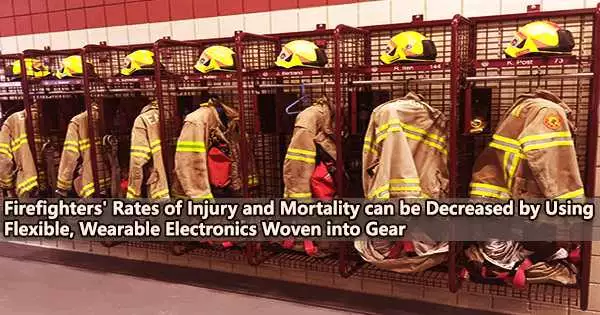Firefighters’ gear, also known as Personal Protective Equipment (PPE), is specialized equipment designed to protect firefighters from hazards they may face during firefighting and rescue operations. Firefighting may look vastly different in the future thanks to intelligent fire suits and masks developed by multiple research institutions in China.
Researchers have made their findings public, demonstrating that permeable electrodes sewn into fire suit fabric have been shown to be stable at temperatures above 520oC. The fabric is discovered to be substantially non-combustible at these temperatures and to have long thermal protection times.
The study was published on January 12, 2023 in Nano Research.
The findings demonstrate the effectiveness and applicability of Janus graphene/poly(p-phenylene benzobisoxazole) or PBO woven fabric in making firefighting “smarter,” with the main objective being to industrially produce products that are flame-retardant but also intelligent enough to alert the firefighter of increased risks while navigating the flames.
The standard firefighters’ gear includes:
- Helmet: A hard hat to protect the firefighter’s head from falling objects and other hazards.
- Turnout coat: A heavy, insulated coat that is flame-resistant and water-resistant to protect the firefighter from flames and heat.
- Turnout pants: Heavy, insulated pants that are flame-resistant and water-resistant to protect the firefighter from flames and heat.
- Gloves: Fire-resistant gloves to protect the firefighter’s hands from heat and flames.
- Boots: Heavy-duty, insulated boots that are flame-resistant and waterproof to protect the firefighter’s feet and ankles.
- Self-Contained Breathing Apparatus (SCBA): A device worn by firefighters that provides them with clean air to breathe in smoky, hazardous environments.
- Flash hood: A flame-resistant hood that protects the firefighter’s head and neck from heat and flames.
The graphene/PBO woven fabrics-based sensors exhibit good repeatability and stability in human motion monitoring and NO2 gas detection, the main toxic gas in fires, which can be applied to firefighting suits to help firefighters effectively avoiding danger.
Professor Wei Fan
“Conventional firefighting clothing and fire masks can ensure firemen’s safety to a certain extent,” said Wei Fan, professor and researcher at the School of Textile Science and Engineering at Xi’an Polytechnic University. “However, the fire scene often changes quickly, sometimes leaving firefighters trapped in the fire for failing to judge the risks in time. In these situations, firefighters also need to be rescued.”
The key here is the use of Janus graphene/PBO, woven fabrics. PBO fibers outperform other comparable fibers like Kevlar in terms of strength and fire resistance. First, PBO fibers are woven into a cloth, which is then exposed to CO2 infrared laser radiation. The fabric then transforms into the study’s primary research object, the Janus graphene/PBO hybrid.
The mask also uses a piezoelectric layer in between the top and bottom Janus graphene/PBO layers to convert mechanical pressures to electricity and vice versa.
“The mask has a good smoke particle filtration effect, and the filtration efficiency of PM2.5 and PM3.0 reaches 95% and 100%, respectively. Meanwhile, the mask has good wearing comfort as its respiratory resistance (46.8 Pa) is lower than 49 Pa of commercial masks. Besides, the mask is sensitive to the speed and intensity of human breathing, which can dynamically monitor the health of the firemen,” said Fan.
Scaling for industrial production is a real accomplishment because to the flexible, heat-resistant, rapid, and inexpensive flame-retardant electronics used in these fire suits. This increases the likelihood that upcoming firefighting gear, including as suits and masks, will be capable of using this technology. Quick, effective responses can also reduce economic losses attributed to fires.
“The graphene/PBO woven fabrics-based sensors exhibit good repeatability and stability in human motion monitoring and NO2 gas detection, the main toxic gas in fires, which can be applied to firefighting suits to help firefighters effectively avoiding danger,” Fan said.
A vital feature to firefighter equipment is the ability to quickly reverse direction as necessary by detecting sudden surges in NO2 gas. By utilizing graphene/PBO woven and nonwoven materials, significant advancements can be made in the realm of firefighting to better protect the firefighters.
The researchers’ ultimate objective of lowering death and injury among individuals who put their lives in danger fighting fires can be accomplished with the support of widespread use of this technology.
















